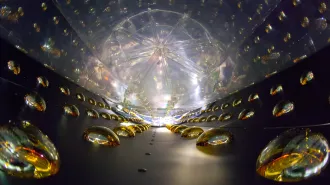Adding a bit of quantum fuzz could provide a free power boost to lasers and solar panels. Blurry atoms that can exist in two states at once should help such devices more efficiently harness energy from light, a new analysis suggests.
“The key is … we can now do things in quantum optics that we didn’t think we could do 20 years ago,” says Marlan Scully of Texas A&M University in College Station and Princeton University, who led the new analysis that will appear in Proceedings of the National Academy of Sciences.
In a semiconductor laser, electrons jump to a higher energy level when struck by light and emit laser light by falling back to a lower energy level. Some of the energy absorbed by the particle inevitably winds up as waste heat.
Customizing lasers at the subatomic scale could reclaim some of this heat. Instead of a single lowest energy level for electrons, atoms can also contain a pair of levels very close together that interact via an effect called quantum interference. Like two ocean waves merging into a larger wave, a pair of energy levels can come together in a new quantum state that shoves electrons up to a higher energy state, helping the atom to convert heat into a beam and potentially doubling the laser’s power.
And unlike a previous proposal by Scully (SN: 6/19/10, p. 12), creating this fuzzy state requires no outside energy to be pumped in.
“From a theoretical point of view, this approach is sound,” says Girish Agarwal, a theoretical physicist who studies quantum optics at Oklahoma State University in Stillwater. “There are many systems that would have these kinds of energy level schemes.”
Fuzzy atoms could also be useful building blocks for solar cells. In a solar cell, electrons that leap upward after being struck by sunlight can generate a current. A fuzzy lower energy level in a solar cell should help to keep electrons from falling back downward before they’ve been put to work. This approach could potentially double the current flowing through a solar cell.
Tweaking atomic energy levels could lead to thinner photovoltaics better able to convert sunlight into electricity — pushing the efficiencies beyond the 33 percent limit predicted by “detailed balance” calculations that don’t include this quantum effect.
Other researchers, though, are skeptical that the quantum trick proposed by Scully and colleagues will produce real-world benefits.
“The proof has got to be in the proverbial pudding,” says Alexander Kirk, a materials scientist who studies solar cells at the University of Texas at Dallas. “He will have to show without ambiguity that his devices can achieve a power conversion efficiency that exceeds that which would be given by detailed balance.”
To answer their critics, Scully’s team plans to create fuzzy energy levels by adding impurities to traditional silicon solar cells.







